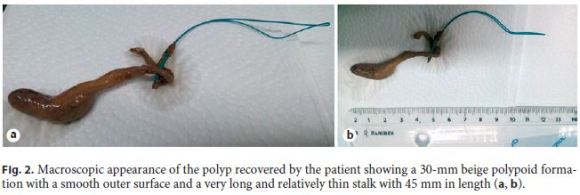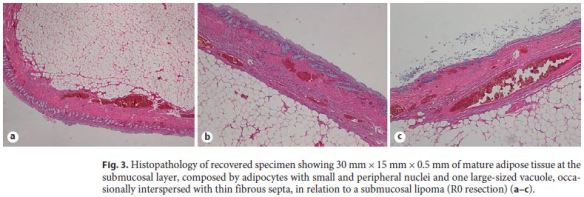Serviços Personalizados
Journal
Artigo
Indicadores
-
 Citado por SciELO
Citado por SciELO -
 Acessos
Acessos
Links relacionados
-
 Similares em
SciELO
Similares em
SciELO
Compartilhar
GE-Portuguese Journal of Gastroenterology
versão impressa ISSN 2341-4545
GE Port J Gastroenterol vol.25 no.5 Lisboa out. 2018
https://doi.org/10.1159/000485350
ENDOSCOPIC SNAPSHOT
Large Pedunculated Lipoma of the Colon: Endoscopic Resection Using Loop-and-Let-Go Technique
Lipoma Pediculado do Cólon de Grandes Dimensões: Resseção Endoscópica Usando a Técnica Loop-and-Let-Go
Elisa Gravito-Soaresa, Marta Gravito-Soaresa, João Fragab, Pedro Figueiredoa,c
aGastroenterology Department, Centro Hospitalar e Universitário de Coimbra, bPathology Department, Centro Hospitalar e Universitário de Coimbra, and cFaculty of Medicine, University of Coimbra, Coimbra, Portugal
* Corresponding author.
Keywords: Pedunculated lipoma, Colon, Endoscopic resection,·Loop-and-let-go technique
Palavras-Chave: Lipoma pediculado, Cólon, Resseção endoscópica,·Técnica loop-and-let-go
We report the case of a 57-year-old female patient with a medical history of osteoporosis, chromophobe renal cell carcinoma submitted to laparoscopic right radical nephrectomy, and nontoxic multinodular goiter under levothyroxine. There was no personal/family history of colorectal cancer. A total colonoscopy was performed due to abdominal pain in the lower quadrants of the abdomen, showing a large polypoid lesion located at 40 cm from the anal verge. The patient was then referred to our institution for colonic polyp resection. A rectosigmoidoscopy was performed showing a large, yellowish, and pedunculated subepithelial lesion with 30 mm of head diameter and 45 mm of stalk length, located at the sigmoid colon (Fig. 1a-c). Considering the lesion benignity in a symptomatic patient, it was decided to perform the polyp resection using a minimally invasive technique – loop-and-let-go. A 30-mm endoloop® (Olympus, Tokyo, Japan) was maneuvered to capture the lipomas head and then carefully placed at the stalk base. A visible reduction in lesion vascularization was verified following sheathcontrolled closure (Fig. 1d-g). A formalin-filled container was given to the patient in case of polyp recovery. The patient recovered the colonic polyp within 4 days of endoscopic ligation and it was sent for histological characterization (Fig. 2a, b). Specimen histopathology showed a 30-mm adipose tissue on the submucosal layer, in relation to a fully-resected submucosal lipoma (Fig. 3a-c). The patient became asymptomatic with an uneventful course. Follow-up colonoscopy at 2 months was normal.



Gastrointestinal lipomas are rare subepithelial benign tumors, being more common in the colon [1–4]. Diagnosis is usually easy because of typical endoscopic features. Large lipomas (>20 mm) may cause symptoms, such as abdominal pain, intestinal obstruction, or bleeding [1–5]. Treatment of colonic lipomas remains controversial. For symptomatic large lipomas, endoscopic resection may be considered. There is no standard technique for their resection and it should therefore be tailored according to the lesion characteristics [1–5]. Currently, there are several available techniques using electrocautery (snare polypectomy, unroofing, ligate-and-resect, ligate-andunroofing, endoscopic mucosal resection (EMR), and endoscopic submucosal dissection) or not (ligate-and-let-go) [5]. Techniques using electrocautery are associated with a high risk of bleeding and perforation due to the lower water content of lipomas and consequently less efficacy in conducting electrosurgical current and need for higher amounts of energy or prolonged current delivery to complete the resection [1–3, 5]. Catchable pedunculated lipomas can be managed with loop-and-let-go, EMR, or loop-and-resect [1–5]. Loop-and-let-go is a recent noninvasive alternative technique with a negligible risk of these complications because of slow transection of the polyp stalk with a high success rate [1, 2, 4, 5]. Drawbacks of this technique include the need for correct stalk visualization, failure to recover the lesion for histopathological characterization and the potential need of further procedures [1, 4, 5]. The patient repositioning, two-endoloops ® use, and unroofing can effectively obviate these limitations [4].
In our case of a large pedunculated lipoma with a long and relatively thin stalk, a loop-and-let-go technique using one endoloop® revealed a simple, safe, and effective procedure. Additionally, the subsequent recovery of the resected specimen by a cooperating patient represents another way to histological attainment, as an alternative to unroofing or ligate-and-resect.
References
1 Ivekovic H, Rustemovic N, Brkic T, et al: Endoscopic ligation (Loop-And-Let-Go) is effective treatment for large colonic lipomas: a prospective validation study. BMC Gastroenterol 2014; 14: 122. [ Links ]
2 Geraci G, Pisello F, Arnone E, et al: Endoscopic resection of a large colonic lipoma: case report and review of literature. Case Rep Gastroenterol 2010; 4: 6–11. [ Links ]
3 Mendes SS, Pinho R, Leite S, et al: Ligate-andresect technique for resection of a large pseudo- pedunculated subepithelial lesion in the ascending colon. GE Port J Gastroenterol 2017, DOI: 10.1159/000478987. [ Links ]
4 Lorenzo D, Gonzalez JM, Benezech A, et al: Endoscopic resection of giant GI lipoma: a case series. VideoGIE 2016; 1(Issue 2):43–46. [ Links ]
5 Raju GS, Gomez G: Endoloop ligation of a large colonic lipoma: a novel technique. Gastrointest Endosc 2005; 62: 988–990. [ Links ]
Statement of Ethics
This study did not require informed consent nor review/approval by the appropriate ethics committee.
Disclosure Statement
The authors have no conflicts of interest do declare.
* Corresponding author.
Dr. Leonor Carmo
Serviço de Cirurgia Pediátrica, Centro Hospitalar Vila Nova de Gaia/Espinho
Unidade 2, Rua Francisco Sá Carneiro
PT–4400-129 Vila Nova de Gaia (Portugal)
E-Mail leonorfmcarmo@gmail.com
Received: October 11, 2017; Accepted after revision: December 11, 2017














